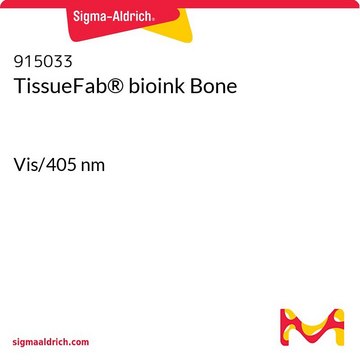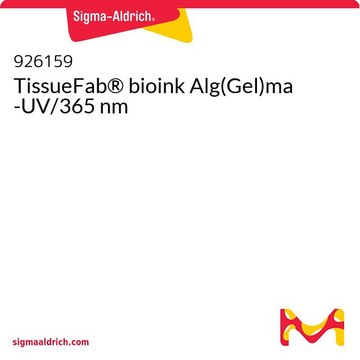926035
TissueFab® bioink Bone UV/365 nm
Synonyme(s) :
3D Bioprinting, Bioink, GelMA, TissueFab
About This Item
Produits recommandés
Forme
viscous liquid
Niveau de qualité
Impuretés
<5 CFU/g Bioburden (Total Aerobic)
<5 CFU/g Bioburden (fungal)
<50 EU/mL Endotoxin
Couleur
white
pH
6.5-7.5
Viscosité
5-50 cP(37 °C)
Application(s)
3D bioprinting
Description générale
HAp is a highly crystalline form of calcium phosphate. HAp has a chemical similarity with the mineralized phase of bone which accounts for their excellent biocompatibility and osteoinductive and osteoconductive properties favorable for bone regeneration. HAp-containing hydrogels has been studied in literature to demonstrate their processability with different additive manufacturing approaches. Printing of cell laden structures with HAp containing bioink formulations have shown superior osteogenic properties.
Additional Information:
The protocol for this material can be found In the Documentation Section under ″More Documents″.
Application
Informations légales
Code de la classe de stockage
10 - Combustible liquids
Classe de danger pour l'eau (WGK)
WGK 3
Faites votre choix parmi les versions les plus récentes :
Certificats d'analyse (COA)
It looks like we've run into a problem, but you can still download Certificates of Analysis from our Documents section.
Si vous avez besoin d'assistance, veuillez contacter Service Clients
Déjà en possession de ce produit ?
Retrouvez la documentation relative aux produits que vous avez récemment achetés dans la Bibliothèque de documents.
Notre équipe de scientifiques dispose d'une expérience dans tous les secteurs de la recherche, notamment en sciences de la vie, science des matériaux, synthèse chimique, chromatographie, analyse et dans de nombreux autres domaines..
Contacter notre Service technique








